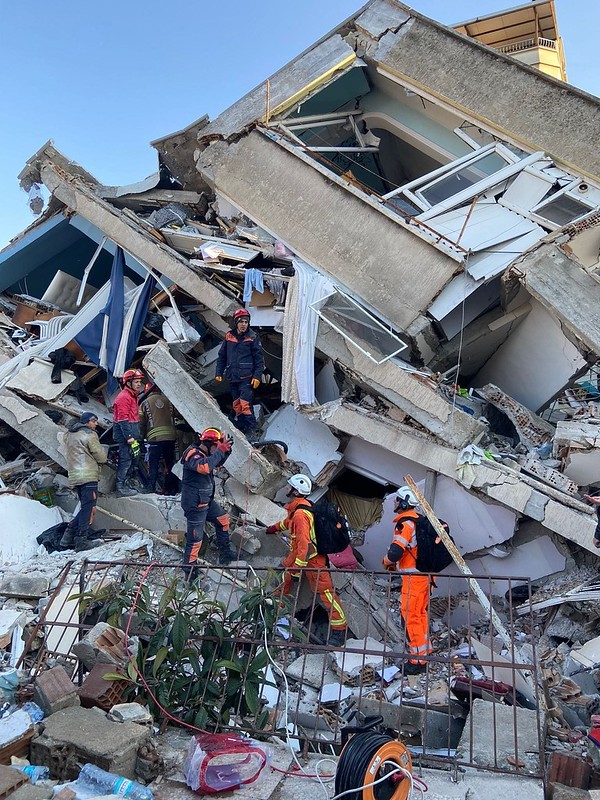News
Turkey-Syria earthquake: the risk of aftershocks and what can be done to protect rescuers

FILE: Hatay, Turkey, 9 February 2023. Members of the UK’s International Search & Rescue Team continue working in coordination with other search and rescue teams looking for survivors. (Photo by UK ISAR Team via Foreign, Commonwealth & Development Office/Flickr, CC BY 2.0)
As the first United Nations aid convoy made it across the Turkish border into Syria, the regional death toll from the earthquakes four days earlier climbed steadily past 19,000. And it looks set to rise higher still. Quite a lot of these will be new deaths, caused by aftershocks and the collapse of buildings and infrastructure already damaged by the February 6 quakes.
An important part of preparing for earthquakes is to plan for a rapid and effective response to widespread destruction. This includes putting systems in place that protect rescue and relief workers from aftershocks, which can take place days or even weeks later and be almost as large as the main shock.
Aftershocks pose a danger to responders because they can cause already damaged buildings and structures to collapse, putting rescue crews at risk of injury or death. They can also trigger additional hazards, such as landslides, gas leaks, fires and rockfalls that can further threaten their safety. They can also complicate response and recovery efforts, making it more difficult for responders to reach and assist those in need.
The risk of aftershocks is always present during an earthquake response and this can cause rescue workers significant stress and fear, undermining their wellbeing and effectiveness.
Foreshocks, main shocks and aftershocks
It is only possible with hindsight to say for certain which seismic event in an earthquake sequence was the main shock and which ones were foreshocks and aftershocks. An aftershock is an earthquake, just like the main shock.
Retrospectively, aftershocks are the smaller earthquakes that follow the larger main shock. They can continue for days, weeks or even months after the main quake. The frequency of aftershocks decreases with time, but it is not uncommon for the largest aftershocks to occur several days or even weeks after the main shock.
On April 25 2015, Nepal faced an earthquake of 7.8 on the moment magnitude (MW) scale. In the 13 months following this event, the country faced 459 aftershocks with magnitudes equal or greater than 4MW.
The largest aftershock (7.3MW) occurred three weeks after the main shock, on May 12. The aftershocks caused further damage to buildings, infrastructure and monuments that had already been damaged or destroyed by the main quake, adding to the death toll and exacerbating the humanitarian crisis.
The aftershocks also hindered relief and reconstruction efforts, making it more difficult for responders to access affected areas. In addition to causing physical damage, the aftershocks also had a significant psychological impact on the population.
People were reluctant to return to their homes and many took refuge in temporary shelters. This disrupted the normal functioning of communities and added to the difficulties faced by relief workers in providing aid and assistance to those in need.
As a result of both the main shock and the aftershocks, 8,632 people died and 22,300 were injured. At least 498,852 private houses and 2,656 government buildings were destroyed.
But this outcome is not the result of the magnitude and the frequency of the earthquakes alone. Nepal had many buildings that were older, poorly constructed and not designed to withstand earthquakes. Many were built with unreinforced masonry or had multiple additional storeys that had been added in an ad hoc manner, making them them vulnerable to earthquakes and putting inhabitants and responders at risk.
Buildings that had already been damaged during the main shock were vulnerable to aftershocks, especially if they were located near the aftershock’s epicentre and soil conditions were poor. For example, loose sand or soil that contains a lot of water can amplify ground motion and increase the damage to buildings. Buildings that are located on slopes are also more vulnerable, especially if the slopes are unstable.
Rapid Response to Earthquake systems
Systems that enable a rapid response to earthquakes include early warnings for aftershocks as well. Such systems help authorities coordinate rescue and relief efforts. They provide ground shaking alerts (for example, via smartphone), giving responders in the field tens of seconds to take protective measures before an aftershock is felt.
These systems rely on earthquake early warning (EEW). This involves using a network of seismographs to detect seismic waves. They work by detecting the faster, less damaging, primary waves (P-waves) of an earthquake. They they use algorithms to quickly estimate the magnitude, location and expected arrival time of the slower, more damaging, secondary waves (S-waves) at different locations.
Unfortunately in some regions, geological conditions are not suitable for EEW, because they limit warnings to two to three seconds before impact, which are of limited value. EEW also does not provide enough warning time if the area that needs to be alerted is located on top of the epicentre.
Some rapid response systems combine this information with data about the built environment to quickly model the expected impact on houses and other structures, showing which areas are likely to be worst affected after an aftershock. An example is the TURNkey system, an EU-funded project aimed at developing a decision support system for earthquake management.
They can also sends responders an “are you safe?” push message through their smartphone. This allows response leaders to quickly assess the wellbeing of their team after an aftershock. It also allows for more effective prioritisation and coordination across the response.
The knowledge that aftershocks won’t come completely unexpected gives responders some peace of mind, reducing their stress and making a difference to the speed and effectiveness of a response.![]()
Femke Mulder, Postdoctoral Research Fellow, Anglia Ruskin University
This article is republished from The Conversation under a Creative Commons license. Read the original article.





















